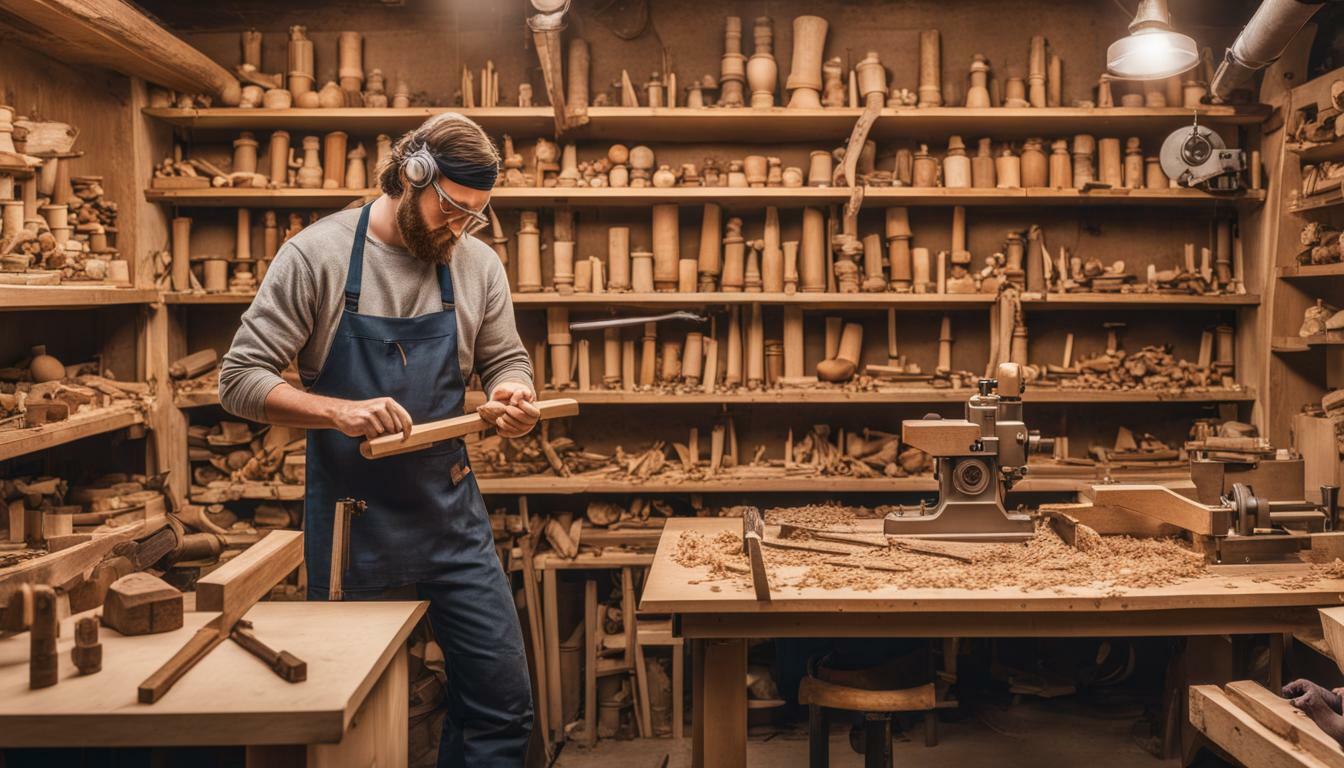
Lathe machines are an important tool for any wood or metalworker. Whether you’re a beginner or an experienced craftsman, understanding the basics of a lathe machine is crucial to creating high-quality projects. In this section, we’ll provide you with a comprehensive guide on how to use a lathe machine effectively. You’ll learn about the essential components of a lathe machine, the different types of lathe tools, and how to use them to achieve the desired results.
Key Takeaways
- Understanding the basics of a lathe machine is essential for beginners to build upon.
- A lathe machine is a versatile tool that can be used for various operations such as turning, facing, and tapering.
- Lathe tools are an important aspect of lathe operations, and choosing the right tool for the job is crucial.
Understanding Lathe Operation
Lathe operation is a fundamental skill for any workshop enthusiast. It involves using a lathe machine to shape and form metal, wood, or other materials into various shapes and sizes. To become proficient in lathe operation, it is essential to understand the basics of the lathe machine and its components.
The lathe machine typically consists of a bed, headstock, tailstock, and tool rest. The bed is the foundation that supports the lathe and provides a flat surface for the headstock and tailstock to move along. The headstock is located at the left end of the bed and contains the motor, spindle, and gear train. The tailstock is located at the right end of the bed and supports the opposite end of the workpiece. The tool rest is an adjustable frame that holds the cutting tool in place.
The lathe machine uses various cutting tools to create different types of cuts. The most common cuts include turning, facing, and tapering. Turning is the process of rotating the workpiece and using a cutting tool to remove material from the surface to create a cylindrical shape. Facing involves cutting a flat surface perpendicular to the workpiece’s axis. Tapering is the process of gradually reducing the diameter of the workpiece from one end to the other.
When operating a lathe machine, it is crucial to follow proper safety precautions to prevent accidents or injuries. Always wear appropriate personal protective equipment, such as safety glasses and gloves. Make sure the workspace is clean and organized, and avoid wearing loose clothing or jewelry that could become caught in the lathe. Avoid touching rotating parts of the lathe machine and keep your hands and fingers away from the cutting tool during operation.
By mastering the basics of lathe operation, you can create a wide variety of projects with precision and skill. With continued practice and exploration of advanced lathe techniques, you can unlock limitless possibilities in your workshop.
Ensuring Lathe Safety
When working with a lathe machine, safety should always be a top concern. Proper precautions must be taken to ensure the safety of the user and anyone in the workshop. Below are some guidelines to follow to minimize the risks of accidents and injuries.
Workspace Setup
The workspace should be kept clean and organized at all times. Make sure there is enough space to move freely and that the lathe machine is placed on a sturdy and level surface. Ensure there is sufficient lighting, ventilation, and access to emergency equipment such as fire extinguishers and first-aid kits.
Personal Protective Equipment
Wearing appropriate personal protective equipment (PPE) is crucial when using a lathe machine. This includes safety glasses, ear protection, and proper attire such as long sleeves and closed-toe shoes. Loose clothing, jewelry, and long hair should be secured to prevent them from getting caught in the machine.
Safe Handling of Lathe Equipment
It is important to use the correct lathe tools and equipment for each task. Always use sharp and properly maintained tools, as dull or damaged tools can cause accidents. When changing the lathe tools, make sure to turn off the machine and wait for it to come to a complete stop before making any adjustments. Always keep your hands away from the moving parts of the lathe and never reach over the machine while it is in operation.
Conclusion
By following these safety guidelines, users can significantly reduce the risk of accidents and injuries when using a lathe machine. Safety should always be a top priority in the workshop, and proper precautions must be taken to ensure everyone’s well-being.
Essential Lathe Techniques
Now that you have a solid understanding of the basics of lathe operation, it’s time to explore some essential lathe techniques to take your projects to the next level. These techniques require practice and precision, but they can produce stunning results when executed correctly. Below are some of the key techniques every lathe operator should know.
Thread Cutting
Thread cutting is a common lathe operation used in projects that require screw threads. This technique involves cutting a groove into the workpiece using a threading tool to create a helical pattern. To execute this technique successfully, it’s important to choose the right threading tool, use the correct pitch for the desired thread, and maintain consistent speed and feed rates.
Grooving
Grooving is a lathe operation used to create narrow channels or slots on the surface of a workpiece. This technique is commonly used to create grooves for O-rings or snap ring grooves. To execute this technique, you’ll need to select the right grooving tool, determine the appropriate depth and width of the groove, and adjust the lathe speed and feed rate accordingly.
Knurling
Knurling is a lathe operation used to create a textured pattern on the surface of a workpiece. This technique is commonly used for grip or aesthetic purposes. To execute this technique, you’ll need to choose the right knurling tool, determine the desired pattern and pitch, and adjust the lathe speed and feed rate accordingly. It’s important to maintain consistent pressure and avoid overloading the tool.
With these essential lathe techniques under your belt, you’re well on your way to becoming a proficient lathe operator. Practice these techniques regularly, and don’t be afraid to experiment with different styles and designs to see what works best for you. Remember to always prioritize safety and use the appropriate protective equipment when operating a lathe.
Optimizing Your Lathe Projects
Mastering lathe operation and techniques is essential, but optimizing your projects takes your skills to the next level. Here are some tips for streamlining your workflow and achieving impeccable results:
Selecting the Right Lathe Tools
Having the right tools is crucial for achieving precise cuts and finishes. When selecting lathe tools, consider the type of material you’re working with, the desired outcome, and the capabilities of your lathe machine. Carbide-tipped tools are ideal for hard materials like steel, while high-speed steel tools work best for softer materials like wood. It’s also important to choose the appropriate tool geometry and size for the task at hand.
Choosing Appropriate Lathe Speeds
The speed at which you operate your lathe can impact the quality of your work. Larger diameters generally require slower speeds, while smaller diameters require faster speeds. When in doubt, consult the manufacturer’s recommendations for proper speeds based on the material and tooling being used. Always start at a lower speed and gradually increase until you achieve the desired result.
Maintaining Your Lathe Machine
Proper maintenance of your lathe machine can help ensure consistent performance and longevity. Regularly clean and lubricate the machine according to the manufacturer’s instructions. Check for wear and tear on the components, such as the belts and bearings, and replace them as needed. Keeping your lathe machine in top condition will not only improve the quality of your projects but also prolong the life of your equipment.
By following these optimization strategies, you can elevate your lathe projects to new heights and achieve the precision and efficiency you desire.
Conclusion
By mastering the basics of lathe operation and implementing effective techniques, you can take your skills to the next level. Safety measures should always be a top priority to ensure a smooth and injury-free workflow in your workshop. Remember to select appropriate lathe tools, maintain the machine regularly, and optimize your project by choosing the right speed. With consistent practice and dedication, you will be able to achieve remarkable results and explore a world of new possibilities in your lathe projects.
FAQ
Q: What is a lathe machine?
A: A lathe machine is a tool that rotates a workpiece on its axis, allowing for various cutting, drilling, and shaping operations to be performed.
Q: What are the essential components of a lathe machine?
A: The main components of a lathe machine include the bed, headstock, tailstock, carriage, chuck, tool post, and various controls for adjusting speed and feed.
Q: What are the different types of cuts that can be achieved with a lathe?
A: A lathe can perform turning, facing, tapering, threading, grooving, knurling, and many other types of cuts.
Q: How can I ensure safety while using a lathe?
A: It is crucial to follow safety guidelines when operating a lathe. This includes setting up a proper workspace, wearing appropriate personal protective equipment, and handling the lathe equipment with care to minimize the risk of accidents.
Q: What are some advanced lathe techniques?
A: Advanced lathe techniques include thread cutting, grooving, knurling, and other precision operations that require skill and practice.
Q: How can I optimize my lathe projects?
A: To optimize your lathe projects, it is important to select the right lathe tools for specific tasks, choose appropriate lathe speeds, and properly maintain the lathe machine for optimal performance.
- Delta Midi Lathe 46-250 Performance - August 27, 2023
- Understanding the Different Parts of a Lathe Machine - August 27, 2023
- Explore Different Lathe Tool Holder Types for Your Projects - August 27, 2023
